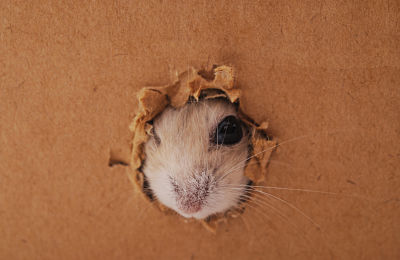
Landlords have a duty of care to ensure there are no vermin in a rental property before a tenant moves in. No tenant wants to be sharing their home with an army of cockroaches, rats, bedbugs or fleas.
The Homes (Fit for Human Habitation) Act 2018 does not explicitly mention vermin, but if a property is overrun with rats, it is arguably not fit for human habitation due to the inherent health risks. Vermin cause numerous health problems, some of them serious.
Even pests that don’t cause serious problems are no less noxious. Given a choice between sharing a house with mice or fleas, most people would have a hard time deciding which one was worse!
If pests are creating mayhem in your rental properties, read on for some useful advice.
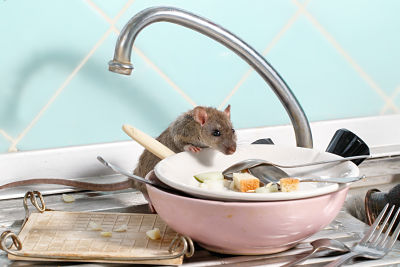
Rats and Mice
Rats don’t have a good reputation, given they were blamed for spreading the Black Death and causing the deaths of 25 million people over several centuries. Bubonic Plague is not really a problem these days, although a recent case in China has sparked some alarm. However, bubonic plague aside, rats and mice are directly responsible for the spread of 35 nasty diseases.
These include:
- Weil’s Disease
- Leptospirosis
- Toxoplasmosis
- Salmonellosis
- Rat bite fever
People can get sick after contact with rat and mouse urine and faeces, as well as fleas, lice, and ticks carried by rats. Being bitten or scratched by rats or mice is also ill-advised. Even if your vermin are not brazen enough to sunbathe on the patio, eating food contaminated by rats and mice is also a health risk.
We won’t dwell on the many symptoms of the above diseases, as they are nasty in the extreme, but suffice to say, many of the diseases caused by rodents can be life-threatening.
As well as causing disease, rodents can also be highly destructive. Rats and mice can gnaw through electricity cables, timber, and even concrete. This can create all kinds of structural issues and increase the risk of a fire breaking out.
Looking for Signs of a Rodent Problem
Your tenants should let you know if they suspect there is a rodent problem, but the main signs include the following:
- Droppings – mice and rats leave droppings wherever they go. Mouse droppings are small, dark pellets whereas rat droppings are longer, bullet-shaped pellets. Look in areas where food is stored, such as kitchen cupboards and pantries. Rodents tend to hang out in areas where food is plentiful, and where they eat, they … poop.
- Holes in walls and around doors – rodents chew holes to gain entry to a property. It’s common to find small holes in skirting boards and around pipework. They will also create holes to make it easier to get around the property.
- Chewed food – rodents are messy eaters. They will happily chew through packets and boxes, even plastic ones, to access food. From personal experience, I know they are pretty good at shelling raw pistachios too.
- Strange noises – listen out for strange scratching noises inside walls, under floors, and in ceiling voids. If you hear anything, the property is infested with rodents or you have a poltergeist. If it’s the latter, call a priest.
- Nasty smell – rodents exude a musky odour, which becomes more obvious as increasing numbers of them take up residence. Dead rodents also smell as they decompose, so be alert to bad stinks, especially in the summer. The smell will eventually fade, but in the short-term, it’s very unpleasant.
- Dogs and cats get excited – plenty of landlords ban pets, but dogs and cats are a useful alarm system for rodents. Most of them go crazy if they suspect a fat rodent is nearby. Pay attention if a pet starts stalking certain areas of the house or provides you with a smoking gun in the form of a recently deceased rodent.
- Electrical problems – unexplained electrical issues, such as wiring faults and dead circuits could be caused by rodents chewing through cables in walls and under floorboards. Call an electrician to do an EICR, which will pick up on any problems.
Preventing a Rodent Infestation
Prevention is always better than curing the problem.
Rodents are attracted by a ready supply of food. If you have a rodent problem make sure you advise tenants to dispose of food waste properly if they aren’t already.
In HMOs, be vigilant for improper waste disposal, such as loose rubbish in the garden or away from the bins, this can occur if there are many people sharing a property. Make sure you provide enough bins in shared houses. This discourages residents from leaving rubbish in loose bin bags, which are an easy target for rodents and other pests.
If there is any rubbish or debris in the garden, clear it. Not only is it a food source if there is food in the rubbish, but boxes and other waste provide shelter for rodents.
Look for access points in and around the property and block them. Holes, where pipes pass through the wall, are a common entry point – patch gaps with mortar and mastic.
Decking is a popular area for rodents, as they can hide out of sight. If decking has been installed over soil or grass, be aware that rodents could be nesting beneath it. Consider removing it if the decking is a likely source of the infestation.
Dealing with a Rodent Infestation
Vermin infestations have risen by 120% since the start of lockdown. The widescale closure of pubs and restaurants has eliminated a major food source for hungry rodents, so they have been entering homes in search of a meal.
Mice and rats are prolific breeders. If you don’t act fast, the situation will reach critical mass very quickly.
Check your landlord insurance to see if there is an add-on that covers rat and mice infestations. If there is, contact your insurer to organise a pest control company. Otherwise, it’s worth trying DIY strategies for a week before you call in the big guns.

There are various DIY methods to get rid of rodents, and DIY stores sell bait and traps.
Traps kill rodents. If it’s a small infestation, a few traps baited with peanut butter and judiciously placed in problem areas might be enough to kill existing rodents and prevent future infestations, but you’ll need to check the traps regularly and reset them if they have been sprung. Be aware that using traps is not for the faint-hearted, as they are pretty brutal.
Poison and bait tunnels are also effective, but they must be placed in high traffic areas. Poison doesn’t work immediately, and if a rodent disappears inside a wall cavity to die, you then have to deal with a very unpleasant stink for several weeks. Using poison is also a non-starter if there are pets and children living in the property.
Some people also swear by plug-in devices that emit high-pitched sound waves and electromagnetic pulses, but how effective they are in the long-term is debatable.
It’s usually better to call in a professional pest control company for more serious infestations. They can deal with the problem quickly and efficiently, thus ensuring it has a minimal effect on your tenants.
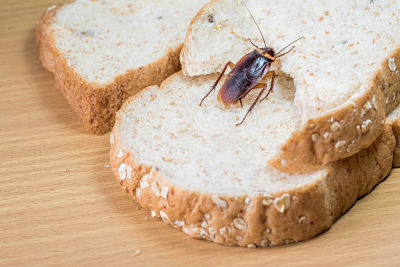
Cockroaches
Cockroaches are a huge problem in many parts of the world. They are also very difficult to eradicate once an infestation takes hold. Like rats, cockroaches spread disease by coming into contact with the food we eat. They are carriers of many serious diseases, including:
- Salmonellosis
- Listeriosis
- Typhoid fever
- Dysentery
- Cholera
- E-coli
In the UK, the main risk of a cockroach infestation is a nasty Staphylococcus infection and a bad dose of diarrhoea, but cockroaches can also exacerbate asthma and other allergies.
Looking for Signs of Cockroaches
A cockroach infestation may not be apparent initially. In the early stages, cockroaches are very small and inconspicuous, plus they only come out at night.
Since cockroaches are mainly nocturnal, the best time to spot them is at night. Turn the lights off and wait for them to appear. If there is an infestation of cockroaches, it won’t be long before they come scuttling out to play.
Look inside kitchen cupboards, behind fridges and freezers, and airing cupboards. It’s common to have multiple clusters, so there may be cockroaches in more than one area.
Cockroaches leave faeces – small black granules or smudges on surfaces. You may also spot old skins left behind as juvenile cockroaches grow to adulthood.
Preventing a Cockroach Infestation
Cockroaches look for food, and nice, warm living conditions, so good hygiene is the first step in preventing a cockroach infestation.
Make sure kitchens are kept clean, with food waste correctly disposed of in bins. Do not allow dirty dishes to pile up in the sink. Dried food like rice and cereals are best stored in sealed containers. Kitchen bins should be taken out and emptied regularly. By removing the main food sources, the property will become less hospitable to cockroaches.
Remind tenants of the above if there are issues with cockroaches in the property, and if the problem is in an HMO, consider hiring a cleaner to do an initial deep clean of the communal areas and visit once a week to keep on top of things.
Seal up gaps and holes where cockroaches can get in. Even small gaps around doors are an access point for cunning little critters.
Make sure there is no decaying organic matter outside the property, as this will attract cockroaches. They are also fond of raw sewage, so deal with blocked drains immediately.
Sometimes, cockroaches are introduced into a home via bags and packaging.
Dealing with Cockroaches
Established cockroach infestations are difficult to treat and not a job for a DIY landlord. Bug sprays will kill a few cockroaches, but it won’t help if you have hundreds of them. Fertile female cockroaches can lay up to 80 eggs a week, which hatch within 100 days. Imagine you have 10 females and do the maths: yep, it’s scary!
If removing the food sources and sealing up gaps hasn’t sorted the issue, it’s time to call in the pros. This is usually the only way to completely eradicate the problem.
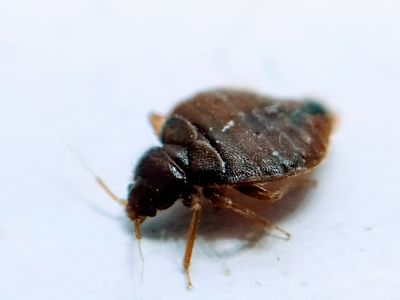
Bedbugs
Bedbugs don’t transmit diseases, but they do cause health problems. Most people don’t like the idea of being eaten alive every time they go to bed and switch the lights out. Bed bug bites are itchy, and in bad cases, the victim can end up with a secondary infection.
It only takes one fertile female bedbug to cause a huge infestation. They spread very easily in clothing, luggage, mattresses, and sleeping bags. In a multi-family HMO, bedbug infestations can cause misery and be extremely difficult to control.
Bedbugs are tiny, and it’s hard to see them unless the infestation is particularly bad. What you will spot, however, are signs of their presence. Look for blood spots and brown and black stains on bed linen and mattresses. You may also see live bugs along mattress seams and in divan bases if you use a torch after dark.
Bedbug bites are another clear sign there is a problem – these look like flea bites and are just as itchy.
Dealing with Bedbugs
If there is a bedbug infestation all bedding and other linens in the property should be washed on a hot wash and tumble dried on a high setting. Vacuum affected areas, including mattresses and divan bases. The vacuum cleaner should be emptied into a sealed bag and the contents placed outside in the bin.
Affected mattresses can be zipped into a sealed cover, which prevents live bugs from escaping. If the mattress cover is left in place for 12 months, any remaining bugs will die. If the mattress is old or totally infested, dispose of it, but make sure the rest of the property is properly treated.
Homes can be treated with insecticide to kill bedbugs and their eggs, but be very careful, as insecticides are toxic to pets and humans. If the infestation is serious and you’re dealing with an HMO, it’s better to call in the experts.
Preventing Bedbugs
It is difficult to prevent bedbug infestations, as they are easily spread. People often pick up bedbugs in hotels, and cleanliness is no barrier to a bedbug infestation. The only thing you can do is treat the infestation as soon as you are aware there is an issue. The longer you leave bedbugs to breed, the bigger the problem.

Fleas
Fleas are just as problematic as bedbugs. Once you have a flea problem, it’s surprisingly difficult to eradicate them. Flea eggs can lie dormant for several years, only hatching when conditions are suitable.
If there is a flea problem in one of your properties, it’s likely to be as a result of pets. Flea problems can also be caused by pets from a previous tenancy.
Failing to treat a flea infestation before a new tenant moves in could cost you a good tenant. Tenants are able to make an official complaint to the local housing department if there is an infestation.
Signs of a flea infestation
Fleas are attracted to heat. Place a cup of tea or coffee on the floor and see how many fleas jump in. It’s a good indication there is a serious flea problem. Being bitten around the ankles is another sign.
Treating flea infestations
If the flea infestation is as a result of the tenant’s current pets ask the tenant to treat their pets with a suitable anti-flea product. Over-the-counter products available from supermarkets are usually woefully ineffective, so they are better off asking their vet to prescribe something more effective. Flea treatments should be administered according to the age and weight of the pet. Most treatments need to be repeated monthly to ensure fleas and their eggs are successfully eradicated.
As well as treating pets, washing bedding and pet beds, regularly vacuuming, and spraying with household insecticide will go some way to curing the problem. However, in serious infestations, it is better to call in a pest control company to tackle the entire property in one go. If you can then leave the property empty for a while, this should cure the problem for good.
Preventing Future Flea Problems
Carpets harbour fleas and their eggs, so removing carpets can help to prevent fleas. Consider fitting laminate rather than carpets in downstairs rooms.
It’s sensible to spray a property with insecticide after a tenant has moved out if they had pets.
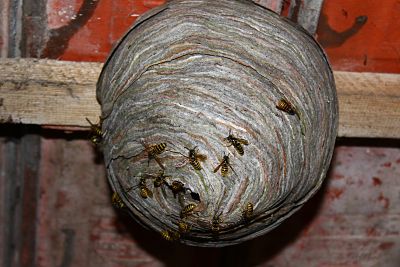
Wasps
Wasps don’t spread disease, but they can cause property damage, and being stung can be fatal if the victim has a severe allergic reaction. Therefore, if a nest is discovered in your rental property, it needs to be dealt with.
Wasps tend to be a problem in spring and summer, as this is when the queen arrives and nest building begins. Wasps use wood pulp and saliva to make their nests. Needless to say, if roof joists are their main food source, it could cause you a few issues. Wasps can also munch through plasterboard walls and ceilings, which will be fun if a nest falls through the ceiling one evening.
Spotting the Signs of a Wasp Nest
Whether wasps nest in an attic, in a ceiling cavity, or inside a cavity wall, your tenants will hear distinctive scratching and crackling sounds as the young wasps move around in the nest. You may also hear buzzing noises.
If there is a wasp nest in the vicinity, you’ll probably see a large number of them flying around outside. Watch carefully to see where the nest access point is. As the months roll by, wasps often become increasingly aggressive. In late summer, wasps can swarm, which is dangerous to anyone allergic to a wasp sting.
You may even spot the nest itself if it is constructed under the eaves or anywhere else outdoors – they can grow surprisingly large by the end of summer.
Removing a Wasps’ Nest
It’s a lot easier to deal with a wasp nest early on in the season when there are fewer wasps, and they are less aggressive. Whilst there are DIY chemicals you can use to eradicate the nest, doing so is dangerous without protective equipment, especially if the nest is located in an inaccessible location.
The most sensible way of dealing with a wasp nest is to call a pest control expert in. It isn’t costly, and they can deal with the problem in less than 30 minutes. Most pest control people will re-treat the nest for free within two weeks if the first treatment doesn’t completely kill the nest.
Preventing Future Wasp Nests
The good news is that wasps don’t return to the same nesting site year after year. So, even if a few errant wasps escaped the massacre, they won’t be back next spring with bloody revenge on their mind. Only the queens survive over winter, and they head out to new locations in early spring.
However, unless you block off the access point, there is a strong possibility a new wasp queen will start building a nest in the same location in future years. So, make it impossible for wasps – or any other critters – to find their way into the property.
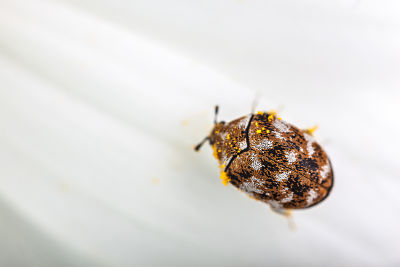
Carpet Beetles and Moths
While carpet beetles and moths are two different creatures, they infest properties and can be dealt with in similar ways.
Carpet beetles are also known as cupboard bugs. They are quite small and can go unnoticed for some time. While they’re commonly found in old carpets (thus the name) they can also be found in properties that don’t have carpets.
Carpet beetles are traditionally attracted to dirty homes. They feed on natural fibres and are particularly fond of hair and feathers. In the wild they tend to feed on pollen and are usually tracked into a home via an open window or pet or just on your clothes. Most of the time the odd carpet beetle won’t do any harm, but if left untreated in a dirty home, they can begin nesting and then you’ll find them everywhere.
Moths are flying insects that range in size from small to large. Moths are attracted to dark and humid areas so are commonly found in bathrooms and darker areas of the home. Like carpet beetles, moths are attracted to clothing and upholstery and natural fibres as these are sources of food for their larvae.
Moths and carpet beetles don’t cause serious diseases, but they can both cause quite serious damage to properties and the items found inside. Carpet beetles are covered in tiny hairs so this can exacerbate asthma and dust allergies.
Signs of a Carpet Beetle and Moth Infestation
Moth larvae and carpet beetles like to feed on natural fibres, so initial signs of infestation are usually holes in clothing, carpets, sofas, curtains and other soft furnishings. These aren’t the only sources of food these pests are interested in though, in a dirty property they will happily infest cupboards and floors and anywhere crumbs and spilt food can be found.
Other signs of infestation include finding skins or pupae around the property. Carpet beetles start out as larvae and as they grow they shed their skins and become small flying beetles. They leave these skins behind, and finding these around the property or more commonly around discarded clothes are a very clear indication of a more serious infestation. Moths also start as larvae and they cocoon themselves to turn into moths, the cocoon they leave behind, also known as pupae, are an indication that you have a moth infestation.
Aside from these you may notice the creatures themselves. Commonly finding moths or small beetle like creatures around the home are a sure fire sign that you have a serious problem.
Treating a Carpet Beetle or Moth Infestation
Carpet beetles and moths can be tricky to get rid of because both can travel quite far. If you see a carpet beetle or moth in one area of your home, there’s no guarantee that they are nesting anywhere close by.
As both of these pests are attracted to dirty homes the treatment needs to be twofold. On the one hand you need to find the source of any nests, and there may well be more than one. These nests or the epicentres of the infestation need to be eradicated. On the other hand you need to make the property hygienic again to remove all sources of food.
There are commercially available poison treatments for both moths and carpet beetles and often the same poison will do for both. These should be used with care as they can be irritants for humans and potentially a lot more damaging for pets.
The property should be hoovered regularly and any infested fabrics should ideally be thrown away or at the very least washed in very hot water to get rid of eggs and larvae. Poison should be put down according to manufacturers instructions at the source of infestation and surrounding areas. Any infested areas that are missed will cause the infestation to proliferate once again.
Due to the difficulty in treating an infestation of moths and carpet beetles and given how extensive the treatment usually has to be, it is often best to call in an expert to deal with an infestation of this kind.
Preventing Future Carpet Beetle or Moth Infestations
For both moths and carpet beetles, the best way to prevent an infestation is to keep the property clean. A clean property heavily diminishes food sources for both pests and creates an inhospitable environment in which to breed which generally prevents issues.
Consider laying laminate instead of carpets as this is a lot more hygienic and it tends to be harder wearing and causes less problems with moths and carpet beetles over the lifetime of the tenancy.
If you’ve had to deal with a moth or carpet beetle infestation in your rental property you should give tenants a reminder to keep the property clean. Both moths and carpet beetles are particularly drawn to clothing that has perspiration on it, so make sure your tenants aren’t leaving dirty clothes to build up around the property. Ensure your tenants know to clear up food spills and that they regularly hoover to pick up crumbs, dust and hair.
If any of the above pests show up in one of your rental properties, do not ignore the issue. It will not go away on its own! Remember, time is of the essence, so in most cases, it is best to seek professional help sooner rather than later – read reviews and look for a well reputed pest control company to avoid any further issues. Check your landlord insurance, too, just in case you are covered.
Have you had experience with any of the pests discussed above? Let us know. You can contact us on Twitter or Facebook. We’d love to hear how you’ve dealt with infestations in your properties.



